
1. 4. OPTIMISITATION IN MATERIAL SELECTION
1.1. 1. Purpose
1.1.1. Choose the best material from the list made after the discrimination
1.1.1.1. TARGET
1.1.1.1.1. Maximised
1.1.1.1.2. Minimized
1.2. 2. Semi-systematic by minimizing the material costs
1.2.1. Mathematical expression in terms of properties is used. It is maximized
1.2.2. High precision
1.2.3. Formulas
1.2.3.1. W_lin=sum (a_i * E_i)/R_i
1.2.3.1.1. Decisions
1.3. 3. Selection of materials by minimizing the material costs
1.3.1. Engeneering beam
1.3.1.1. Design criteria
1.3.1.2. Objective function
1.3.1.3. Values of the Desing paramteres
1.3.2. Steps
1.3.2.1. 1. Dedicate the function for minimum value
1.3.2.2. 2. Derive the merit parameters
1.3.2.3. 3. Find the material with the largest merit parameter
1.3.2.4. 4. Between the materials with largest merit parameters choose the one that has the lowest cost.
1.4. 4. Value of weigh savings
1.4.1. Alluminium alloys
1.4.1.1. Propertie
1.4.1.1.1. Find the best material
1.4.1.2. Mathematical expression
1.4.1.2.1. High precision
1.4.1.2.2. Maximize properties
2. 3. DISCRIMINATING MATERIALS SELECTION
2.1. 1. Purpose
2.1.1. Requeriments on a component
2.1.2. Find out which materials function with the requeriments.
2.2. 2.prerequisite
2.2.1. One or more combinations of design configuration
2.2.2. Sorting stage has to be replete adds for each combination
2.3. 3. Formulation in demands
2.3.1. Huge importance because the limits define if the the material is function able or not
2.3.1.1. Properties
2.3.1.1.1. Maximum (I-th propertie< Maximun limit
2.3.1.1.2. Minimum values: (I-th propertie > lower limit)
2.3.1.2. Strictly relation
2.3.1.3. Allocation between 5 -20 requirements
2.3.1.4. Importance of materials data bases
2.4. 4.representation of properties values
2.4.1. Properties
2.4.1.1. Relevance for the use
2.4.1.1.1. Corrosion
2.4.1.1.2. Wear resistance
2.4.1.2. Manufacturing
2.4.1.2.1. Machinability
2.4.1.2.2. Weld ability
2.4.1.3. Availability
2.4.1.3.1. Material price
2.5. 5. Examples
2.5.1. Car bumper in aluminum
2.5.1.1. Prelevance for the use
2.5.1.1.1. Strength
2.5.1.1.2. Corrosion
2.5.1.2. Manufacturing
2.5.1.2.1. The cold formability must be upper than the minimum limit
2.5.1.3. Availabilty
2.5.1.3.1. Alloy must be available
3. 2. PRE-SELECTION OF MATERIALS
3.1. Purpose of Pre-Selection
3.1.1. Selection according to the different types of materials ( omission of unsuitable materials)
3.2. Intuitive Approach
3.2.1. Consideration of the characteristical properties
3.3. Systematic Approach
3.3.1. Informative properties where the values are comparable with the different types of materials
3.3.2. Is quantitative
3.3.3. Limited number of properties
3.3.3.1. Environmental resistance
3.3.3.1.1. Chemical environment
3.3.3.1.2. Uv resistance
3.3.3.1.3. Radiation
3.3.3.2. Temperature of use
3.3.3.2.1. New Node
3.3.3.3. Physical
3.3.3.3.1. Ductibility
3.3.3.3.2. Durability
3.3.3.3.3. Tenacity
3.3.3.3.4. Density
3.3.3.4. Mechanical
3.3.3.4.1. Elongation
3.3.3.4.2. Tensile strength
3.3.3.5. Price
3.3.3.5.1. Cost
3.4. Examples for Pre-Selection
3.4.1. CASEROLE
3.4.1.1. Which are the properties of the material and how it works
3.5. Base Materials for Pre-Selection
3.5.1. The most important reason of the pre selection of materials is to eliminate the bad ones and the ones that don't work as we wonder
3.5.2. It considers ONLY GROUPS
4. 1. INTRODUCTION
4.1. The need for material selection
4.1.1. Materials
4.1.1.1. More than 100000 types
4.1.1.2. Editing processes in terms of materials
4.1.1.2.1. Many new materials
4.1.1.2.2. Many new material types
4.1.1.2.3. New manufacturing methods
4.1.1.2.4. Properties of existing materials improved
4.1.1.2.5. Increased use of advanced materials
4.1.1.2.6. Entirely new desingn configurations feasible
4.1.1.2.7. Increased competition between materials
4.1.1.3. Many materials for the same function
4.2. Intuitive methods in material selection
4.2.1. They are not based on a systematic analysis . Many mistakes with this method. Poor competitiveness.
4.2.1.1. Same group of materials but better properties
4.2.1.2. FIRST BEST MATERIAL design engineer Choose a material that is familiar with
4.2.1.3. Same material for different functions
4.2.1.4. Random
4.3. Basics of systematic material selection
4.3.1. For avoid the mistakes material selection needs a systematic analysis
4.3.2. The most important reason for make it is to ensure that the component functions well
4.3.2.1. WHY
4.3.2.1.1. Full use
4.3.2.1.2. To avoid expensive costs
4.3.2.1.3. To avoid failures
4.3.2.2. WHEN
4.3.2.2.1. Development,redesign and discovered failures
4.3.2.3. WHO
4.3.2.3.1. Design engineering
4.3.2.3.2. Material engineering
4.3.2.4. HOW
4.3.2.4.1. 1. Formulation for the function specification
4.3.2.4.2. 2. Transfer requirements to the material properties
4.3.2.4.3. 3. Analysis of the consequences
4.3.2.4.4. 4. Find the materials that satisfy (1.)
4.3.2.4.5. 5. Identify the best one.
4.3.3. Minimisation of costs
4.4. Connection to design
4.4.1. Between Material selection and Desing
4.4.1.1. PART LEVEL
4.4.1.1.1. 1. Simple part
4.4.1.1.2. 2. Component
4.4.1.1.3. 3. Product
4.5. General guidelines for successful material selection
4.5.1. To avoid mistakes
4.5.1.1. 1. Act systematically
4.5.1.1.1. To know where are going to end
4.5.1.2. 2. Formulation of the requirements needeed
4.5.1.2.1. To define specifically what the problem is
4.5.1.3. 3. Formulations of requirements only by the engineers on charge
4.5.1.3.1. To have better knowledge about the problem
4.5.1.4. 4. Proceed stepwise
4.5.1.4.1. To have conditions for the next requeriments.
4.5.1.5. 5. Knowledge about properties
4.5.1.5.1. To formulate conditions
4.5.1.6. 6. Check the consistency of the solution
4.5.1.6.1. 6.1 materials that are well known
4.5.1.6.2. 6.2 materials candidates
4.6. Function especification
4.6.1. Specify requirements
4.6.1.1. DEMAND PROFILE OF THE PART
4.6.1.1.1. Performance specifications
4.6.1.1.2. Desing configuration
4.6.1.2. Formulationof functional requirements
4.6.1.2.1. Independence between Desing and materials solutions
4.6.1.2.2. Not formulate in material properties
4.6.1.2.3. All essential requeriments included
4.6.1.2.4. Quantitative terms
4.6.1.2.5. Costs
4.6.1.2.6. Best info
